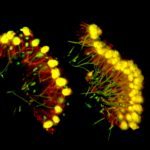Link to Pubmed [PMID] – 37751712
Link to DOI – 10.1016/j.cub.2023.07.054
Curr Biol 2023 Sep; 33(18): R966-R985
Tissue deformation mediated by collective cell contractility is a signature characteristic of animals. In most animals, fast and reversible contractions of muscle cells mediate behavior, while slow and irreversible contractions of epithelial or mesenchymal cells play a key role in morphogenesis. Animal tissue contractility relies on the activity of the actin/myosin II complex (together referred to as ‘actomyosin’), an ancient and versatile molecular machinery that performs a broad range of functions in development and physiology. This review synthesizes emerging insights from morphological and molecular studies into the evolutionary history of animal contractile tissue. The most ancient functions of actomyosin are cell crawling and cytokinesis, which are found in a wide variety of unicellular eukaryotes and in individual metazoan cells. Another contractile functional module, apical constriction, is universal in metazoans and shared with choanoflagellates, their closest known living relatives. The evolution of animal contractile tissue involved two key innovations: firstly, the ability to coordinate and integrate actomyosin assembly across multiple cells, notably to generate supracellular cables, which ensure tissue integrity but also allow coordinated morphogenesis and movements at the organism scale; and secondly, the evolution of dedicated contractile cell types for adult movement, belonging to two broad categories respectively defined by the expression of the fast (striated-type) and slow (smooth/non-muscle-type) myosin II paralogs. Both contractile cell types ancestrally resembled generic contractile epithelial or mesenchymal cells and might have played a versatile role in both behavior and morphogenesis. Modern animal contractile cells span a continuum between unspecialized contractile epithelia (which underlie behavior in modern placozoans), epithelia with supracellular actomyosin cables (found in modern sponges), epitheliomuscular tissues (with a concentration of actomyosin cables in basal processes, for example in sea anemones), and specialized muscle tissue that has lost most or all epithelial properties (as in ctenophores, jellyfish and bilaterians). Recent studies in a broad range of metazoans have begun to reveal the molecular basis of these transitions, powered by the elaboration of the contractile apparatus and the evolution of ‘core regulatory complexes’ of transcription factors specifying contractile cell identity.

